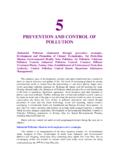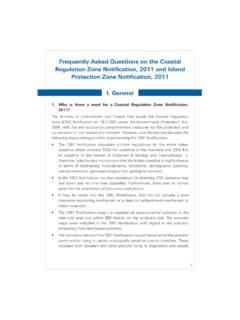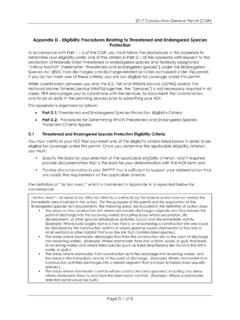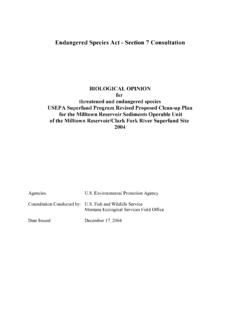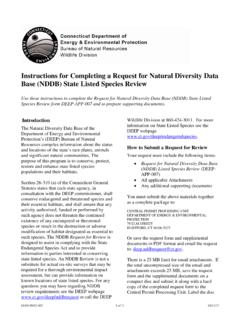Transcription of Kartik Shanker - Ministry of Environment, Forest …
1 For more information, contact:Jagdish KishwanAdditional Director General of Forests Ministry of Environment and Forests email: VenkataramanDirector, Zoological Survey of India, Kolkatta email: of Environment and ForestsGOVERNMENT OF INDIAK artik ShankerFront cover: Bengal Florican mating display, Manas National Park, AssamBack cover: Leatherback turtle hatchlings, Little AndamansLithographs: Bikram Grewal personal collection Ministry of Environment and Forests, March, 2011Cr i t iC a l l y En d a n gE r E d an i m a l Sp E Ci E S o f in d i aRamki SrinivasanZoological Survey of IndiaMinistry of Environment and ForestsGOVERNMENT OF INDIAma rC h 2011 Ministry of Environment and Forests, March, 2011Co n t e n t sForewordIn t r o d uC t I o n - 3BI r d s - 4Ma M Ma l s - 8re p tI l e s - 12aM p hI B Ia n s - 14FI s h - 20sp I d e r s - 22Co r a l s - 232Fo r e w o r dIndia has a staggering variety of flora and fauna, including some of the rarest species in existence on the planet.
2 There is so far a paucity of information for the general public on the status, biology, and major threats to the endangered species of our country. As per the latest (2011) quantitative evaluation done by the International Union for Conservation of Nature (IUCN) there are 57 critically endangered species of animals in am pleased to therefore introduce this booklet on Critically endangered Animal Species of India - a pioneering attempt by the Ministry of Environment and Forests in collaboration with Zoological Survey of India to, for the first time, catalogue and share information on these species, presented in a concise and visually appealing am confident that this booklet will raise the level of awareness among people from all walks of life and strengthen our efforts at RameshMinister of State (Independent Charge)Environment & ForestsGovernment of India9th March, 2011 Critically endangered is the highest risk category assigned by the IUCN (International Union for Conservation of Nature) re d lI s t to wild species.
3 There are five quantitative criteria to determine whether a taxon is threatened. A taxon is critically endangered when the best availabile evidence indicates that it meets any of the following criteria:I. Populations have declined or will decrease, by greater than 80% over the last 10 years or three generations. II. Have a restricted geographical range. III. Small population size of less than 250 individuals and continuing decline at 25% in 3 years or one generation. IV. Very small or restricted population of fewer than 50 mature individuals. V. High probability of extinction in the wild. 3 Least ConcernNear Risk CategoryVulnerableEndangeredCritically endangeredExtinct in the wildExtinctRisk CategoryPink-headed Duck Jerdon s CourserHimalayan Quail1. The Jerdon s Courser (Rhinoptilus bitorquatus) is a nocturnal bird found only in the northern part of the state of Andhra Pradesh in peninsular India. It is a flagship species for the extremely threatened scrub jungle.
4 The species was considered to be extinct until it was rediscovered in 1986 and the area of rediscovery was subsequently declared as the Sri Lankamaleswara Wildlife : Undisturbed scrub jungle with open areas. Distribution: Jerdon s Courser is endemic to Andhra Pradesh. However, 19th century records do attribute its presence in the neighbouring areas of the state of : Clearing of scrub jungle, creation of new pastures, growing of dry land crops, plantations of exotic trees, quarrying and the construction of the Telugu-Ganga Canal. Illegal trapping of birds is also a The Forest Owlet (Heteroglaux blewitti) had been lost for more than a century. It has an interesting history. When not sighted for decades, posters were printed and Salim Ali, the premier ornithologist of India made a public appeal to look for the bird. After 113 long years, the owlet was rediscovered in 1997 and reappeared on the list of Indian birds.
5 Habitat: Dry deciduous : South Madhya Pradesh, in north-west Maharashtra and north-central Maharashtra. Threats: Logging operations, burning and cutting of trees damage roosting and nesting trees of the Forest The White-bellied Heron (Ardea insignis) is an extremely rare bird found in five or six sites in Assam and Arunachal Pradesh, one or two sites in Bhutan, and a few in Myanmar. It is inherently rare, and populations have never been known to be very : Rivers with sand or gravel bars or inland lakes. Distribution: Bhutan and north-east India to the hills of Bangladesh and north Myanmar. Threats: Loss and degradation of lowland forests and wetlands through direct exploitation and disturbance by humans.(A) BIRDSS imon CookIan MerrillSujan Chatterjee4 Ramki SrinivasanRamki SrinivasanKalyan VarmaWhite-backed VultureLong-billed VultureRed- headed VultureSlender-billed VultureRamki Srinivasan5 Out of nine species of vultures, the population of three species- White-backed Vulture (Gyps bengalensis), Slender-billed Vulture (Gyps tenuirostris) and Long-billed Vulture (Gyps indicus) has declined by 99%.
6 The Red- headed Vulture (Sarcogyps calvus) has also suffered a rapid decline in the recent past. Vultures keep the environment clean, by scavenging on animal carcasses. The decline in vulture populations has associated disease risks, including increased risk of spread of rabies and anthrax, besides adversely impacting the observance of last rites by the Parsis in the Towers of : Forests, villages : Across : A major threat to vultures is the painkiller diclofenac used by veterinarians to treat cattle. When vultures consume these carcasses, diclofenac enters their system, but they are unable to metabolize it. Accumulation of diclofenac results in gout-like symptoms such as neck-drooping, ultimately leading to The Himalayan Quail (Ophrysia superciliosa) is presumed to be extinct since no reliable records of sightings of this species exist after 1876. Intensive surveys are required as this species is hard to detect due to its reluctance to fly and its preference for dense grass habitats.
7 Possible sighting of this species was reported in Nainital in : Tall grass and scrub on steep : Western : Indiscriminate hunting during the colonial period along with habitat The beautiful Pink- headed Duck (Rhodonessa caryophyllacea) has not been conclusively recorded in India since 1949. Males have a deep pink head and neck from which the bird derives its : Overgrown still-water pools, marshes and swamps in lowland forests and tall : Recorded in India, Bangladesh and Myanmar. Maximum records are from north-east : Wetland degradation and loss of habitat, along with hunting are the main causes of its The Bengal Florican (Houbaropsis bengalensis) is a rare bustard species that is very well known for its mating dance. Among the tall grasslands, secretive males advertise their territories by springing from the ground and flitting to and fro in the air. Habitat: Grasslands occasionally interspersed with : Native to only 3 countries in the world - Cambodia, India and Nepal.
8 In India, it occurs in 3 states, namely Uttar Pradesh, Assam and Arunachal : Ongoing conversion of the bird s grassland habitat for various purposes including agriculture is mainly responsible for its population Dalvi612. The Spoon Billed Sandpiper (Eurynorhynchus pygmeus) requires highly specialized breeding habitat, a constraint that has always kept its population scarce. India is home to some of the last existing wintering grounds of this species (estimated at only 150-320 breeding pairs worldwide).Habitat: Coastal areas with sparse vegetation. No breeding records further inland than 7 km from the : Has been recorded in West Bengal, Orissa, Kerala and Tamil : Habitat degradation and land reclamation. Human disturbance also leads to high incidence of nest The Siberian Crane (Grus leucogeranus) is a large, strikingly majestic migratory bird that breeds and winters in wetlands.
9 They are known to winter at Keoladeo National Park, Rajasthan. However the last documented sighting of the bird was in : Wetland : Keoladeo National Park in : Pesticide pollution, wetland drainage, development of prime habitat into agricultural fields, and to some extent, Chatterjee11. The Sociable Lapwing (Vanellus gregarious) is a winter migrant to India. This species has suffered a sudden and rapid population decline due to which it has been listed as critically endangered . Habitat: Fallow fields and scrub : Kazakhstan, Russia, Kyrgyzstan, Tajikistan, Uzbekistan, Turkmenistan, Afghanistan, Armenia, Georgia, Azerbaijan, Iran, Iraq, Saudi Arabia, Syria, Turkey, Egypt, India, Pakistan and Oman. In India, distribution is restricted to the north and north-west of the : Conversion of habitat to arable land, illegal hunting and proximity to human Srinivasan71. The Pygmy Hog (Porcula salvania) is the world s smallest wild pig, with adults weighing only 8 kgs.
10 This species constructs a nest throughout the year. It is one of the most useful indicators of the management status of grassland habitats. The grasslands where the pygmy hog resides are crucial for the survival of other endangered species such as Indian Rhinoceros (Rhinoceros unicornis), Swamp Deer (Cervus duvauceli), Wild Buffalo (Bubalus arnee), Hispid Hare (Caprolagus hispidus), Bengal Florican (Eupodotis bengalensis) and Swamp Francolin (Francolinus gularis). In 1996, a captive-breeding programme of the species was initiated in Assam, and some hogs were reintroduced in Sonai Rupai area in 2009.* Pygmy hog-sucking Louse (Haematopinus oliveri), a parasite that feeds only on Pygmy Hogs will also fall in the same risk category of critically endangered as its survival is linked to that of the host : Relatively undisturbed, tall terai grasslands. Distribution: Formerly, the species was more widely distributed along the southern Himalayan foothills but now is restricted to only a single remnant population in Manas Wildlife Sanctuary and its buffer : The main threats are loss and degradation of grasslands, dry-season burning, livestock grazing and afforestation of grasslands.


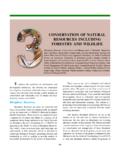


![Untitled-1 [www.moef.nic.in]](/cache/preview/0/7/5/4/5/e/c/5/thumb-07545ec5a24fcdf0c4f7836434cadcc8.jpg)
